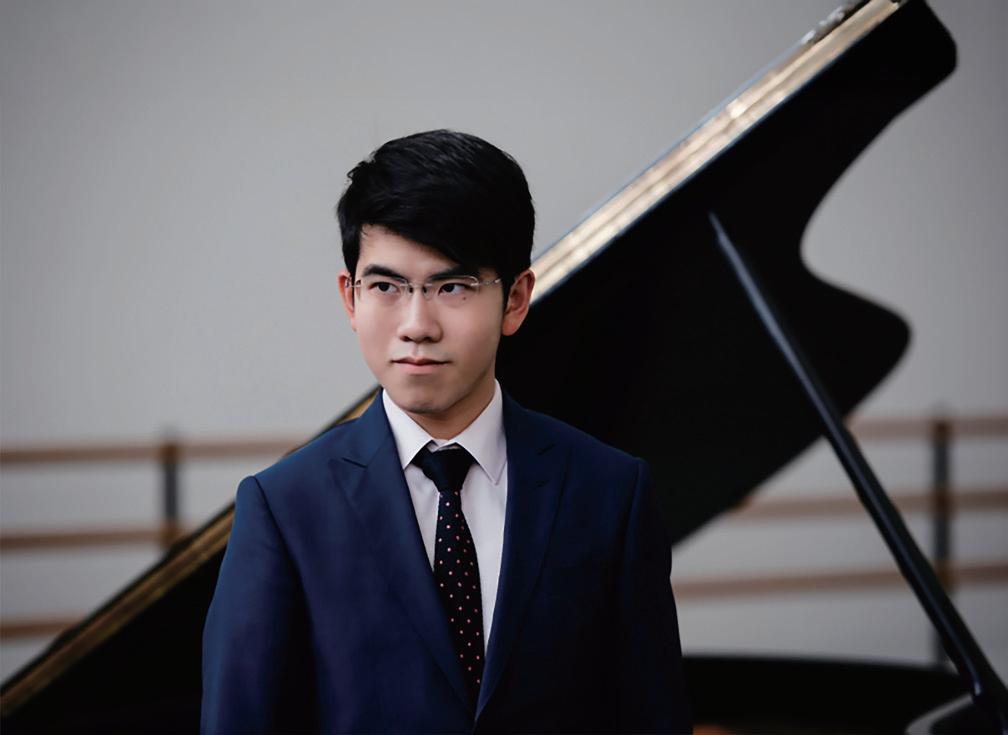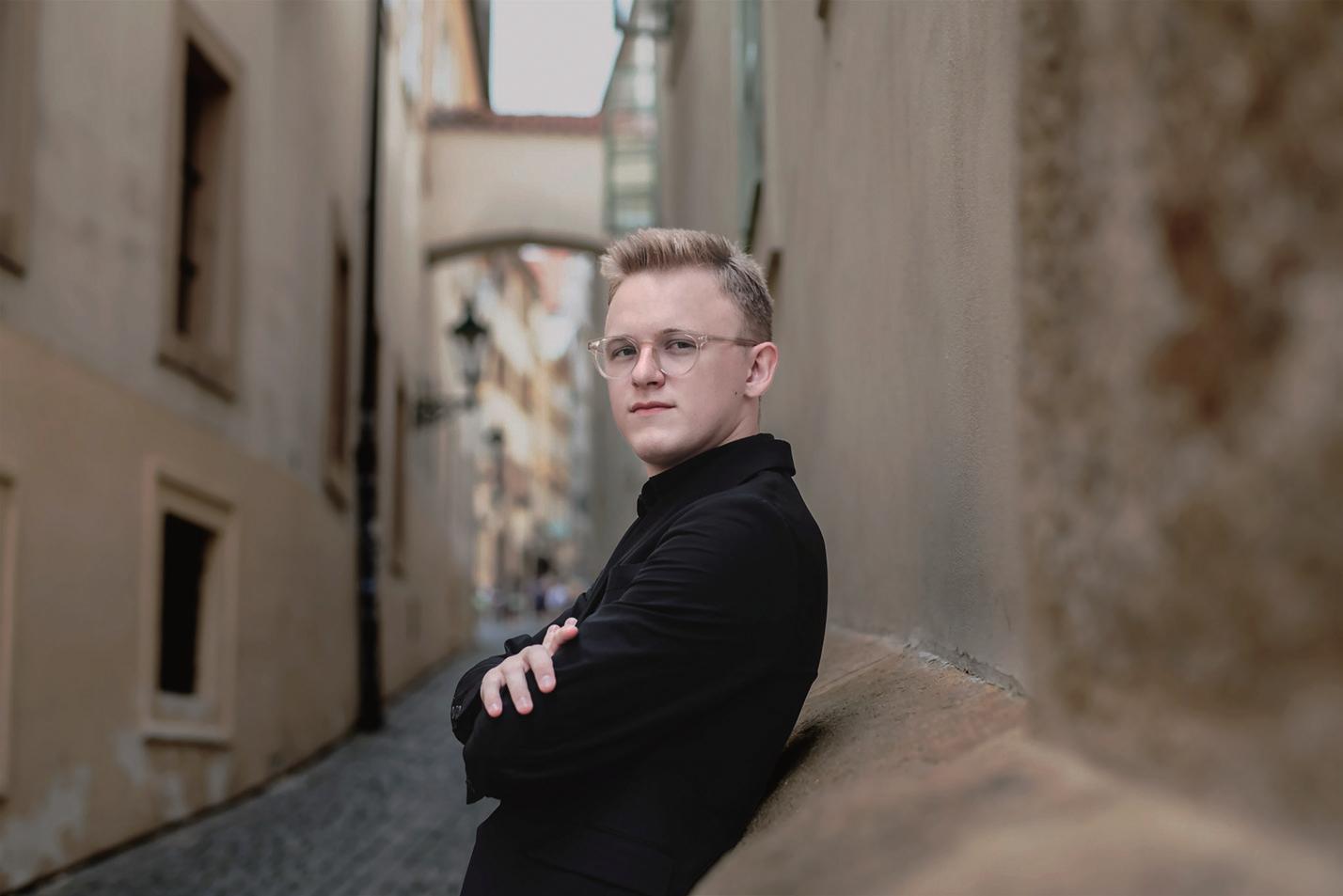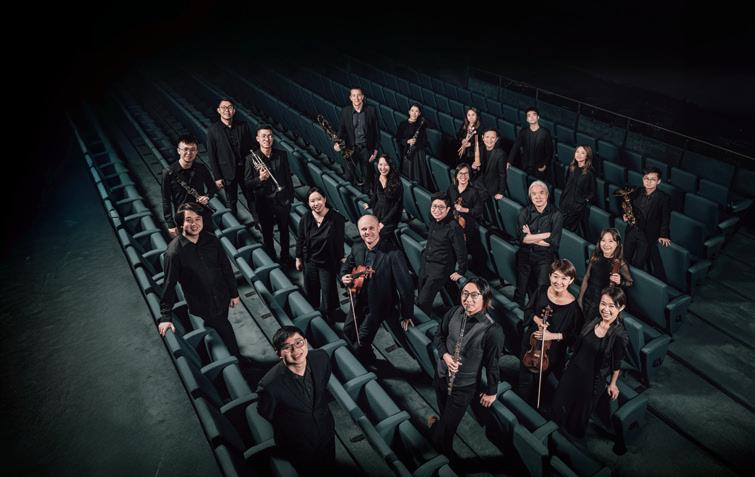
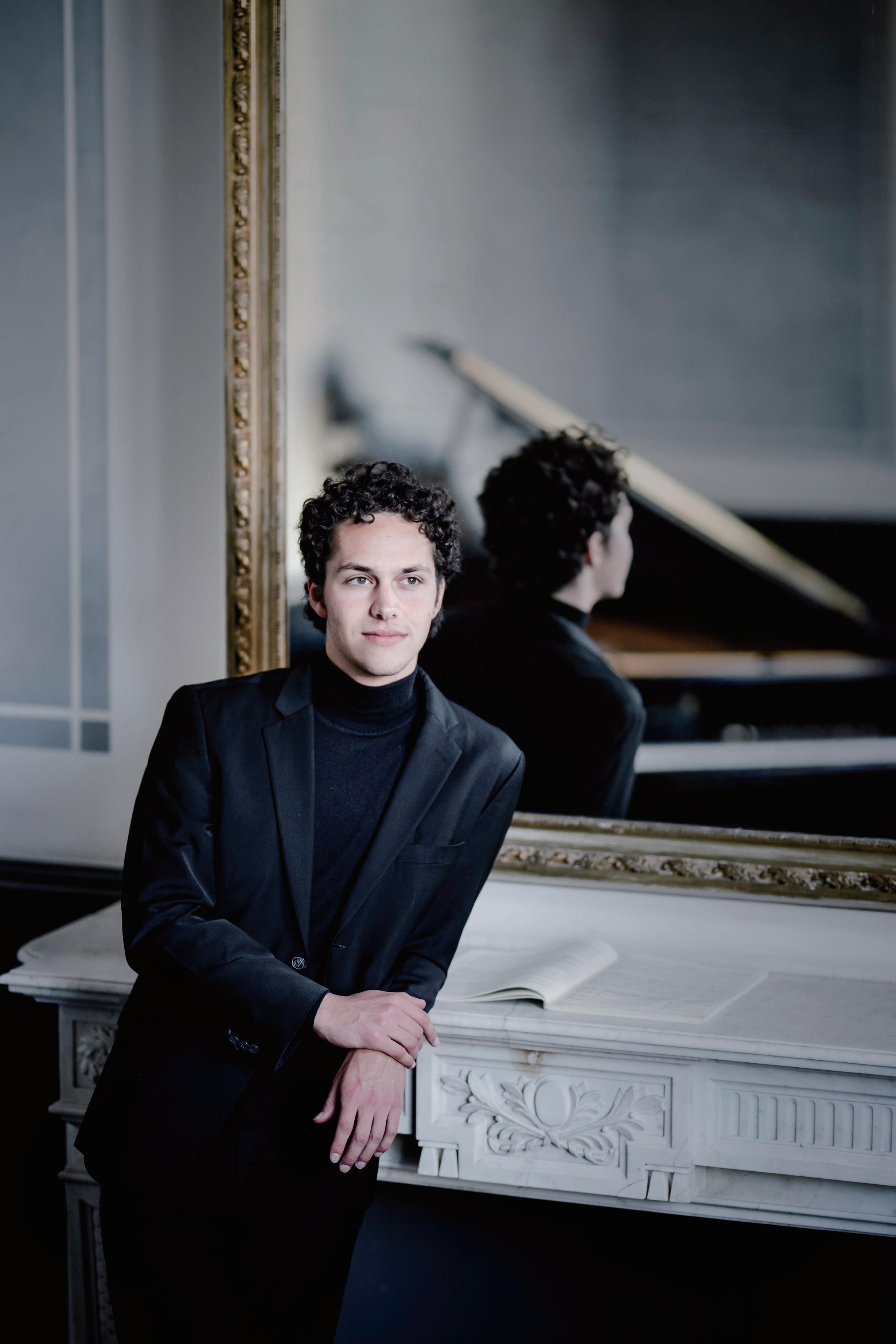









Thank you for coming to this HKU MUSE event. To ensure that everyone enjoys the music, please switch off your mobile phones and any other sound and light emitting devices before the performance. Unauthorised photography and audio/video recordings in the Hall are prohibited. Enjoy the concert and come again.
13 SEP 2025 | SAT | 8PM
Grand Hall, The University of Hong Kong
MENDELSSOHN Variations sérieuses in D minor, Op. 54
PROKOFIEV Suggestion diabolique, Op. 4, No. 4
SHOSTAKOVICH
Piano Sonata No. 2 in B minor, Op. 61
Allegretto
Largo
Moderato (con moto) – Allegretto con moto – Adagio – Moderato
- INTERMISSION -
MOZART
Piano Sonata No. 4 in E-flat major, K. 282
Adagio
Menuetto I & II
Allegro
SCHUMANN Fantasie in C major, Op. 17
Durchaus phantastisch und leidenschaftlich vorzutragen
Mässig. Durchaus energisch
Langsam getragen. Durchweg leise zu halten
In 2025, Nikola Meeuwsen (born 2002) made history by becoming the first Dutch pianist to win the First Prize at the Queen Elisabeth Competition in Brussels. This triumph has given his young and admirable career a powerful boost. Upcoming highlights in the 2025–26 season include a solo recital in the Concertgebouw Amsterdam's Great Pianists series, engagements with the Rotterdam Philharmonic Orchestra, an appearance in the NTR ZaterdagMatinee series, and major tours across China, Korea, Japan, and Brazil.
Nikola draws deep inspiration from the individualistic and expressive style of Romantic-era pianists like Horowitz, Cortot, and Rachmaninov. Critics praise Nikola for his rich palette of colours, compelling artistic vision, and personal style, which balances power with poetry.
Already in demand across Europe, Meeuwsen made his solo debut at the Concertgebouw in Amsterdam in 2024. He has since performed with orchestras such as the Belgian National Orchestra, the Residentie Orkest The Hague, the Netherlands Philharmonic Orchestra, the Folkwang Kammerorchester Essen, and the Prague Symphony Orchestra.
As a chamber musician, Nikola has collaborated with renowned artists including Janine Jansen, Alexander Kerr, Augustin Dumay, Corina Belcea, Vladimir Mendelssohn, Nobuko Imai, as well as leading young musicians such as Noa Wildschut, Benjamin Kruithof, SongHa, Leonhard Baumgartner, and Alexander Warenberg. He also regularly performs with his teacher and mentor, Enrico Pace. In recent seasons, Nikola has appeared at prestigious festivals such as the Storioni Festival, the Chamber Music Festival Schiermonnikoog, Classical NOW!, and the St. Magnus Festival.
Nikola displayed exceptional talent from a very early age—winning the Steinway Competition at just nine. He has studied with Marlies van Gent since 2010 and with Enrico Pace at the renowned Accademia Pianistica in Imola since 2014. In 2019, he received the Concertgebouw Young Talent Award and since 2022, he has been an artist in residence at the Queen Elisabeth
Music Chapel, where he studies with Frank Braley and Avedis Kouyoumdjian.
Nikola has recorded for prominent radio broadcasters such as Bayerischer Rundfunk and NPO Klassiek. His debut album with works by Mendelssohn, Liszt, Schumann, and Bach/ Busoni is released late 2025 on the Channel Classics Records label.
At home in The Hague, Nikola Meeuwsen practises on a Bösendorfer grand piano generously loaned by the Dutch Musical Instruments Foundation (NMF).


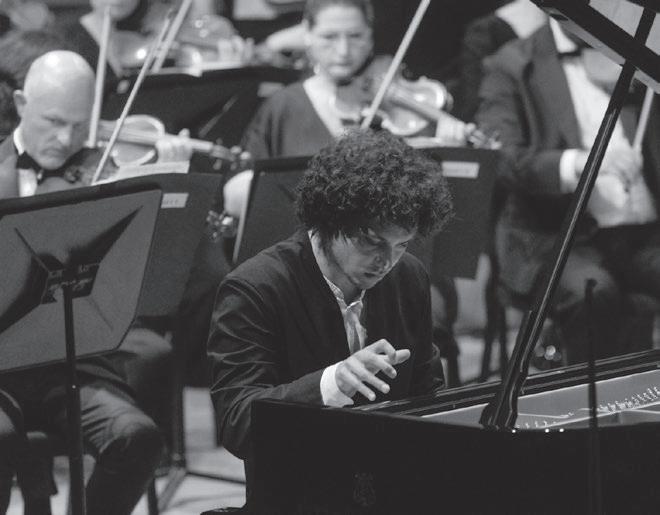



Completed in 1841, Mendelssohn's Variations sérieuses was intended to be included as part of the anthology Album-Beethoven , published in January 1842 by Pietro Mechetti. The purpose of the anthology, to which composers such as Chopin and Liszt also contributed to, was mainly to raise money for the construction of the Beethoven monument in Bonn, Germany. Although Mendelssohn had first declined this invitation, fearing he might not be able to produce a work that could live up to the title of the anthology, he later showed much enthusiasm when he decided to take up the task. He wrote to his friend Karl Klingemann in a letter dated July 15, 1841: "Do you know what I have been doing so passionately for the last few weeks?—variations for piano. 18 of them at one go, on a theme in D minor; and they gave me such a divine pleasure that I immediately wrote a new set on a theme in E-flat major, Op. 82, and am now working on a third on a theme in B-flat, Op. 83. I almost feel as if I have to make amends for not having written variations before."
After many rounds of revisions, the Variations sérieuses , consisting of 17 variations, was premiered in 1841. Mendelssohn also performed the piece in a summer evening of 1846 before some guests, including Richard Wagner and Louis Spohr. Spohr described the piece as "a fearsomely difficult and highly idiosyncratic composition… with monstrous bravura". As indicated in the title, the concept of "seriousness" distinguishes the variations—the idea of a "serious" variations, on one hand, might reflect the composer's reverence for Beethoven and the occasion which the anthology served; on the other hand, it might also suggest Mendelssohn's impression of Beethoven's personality or musical persona.
To write "serious" music, then, Mendelssohn did not prioritise virtuosic brilliance, something often considered key to 19th century aesthetics. The original theme, marked Andante Sostenuto and composed in a four-voice texture, declares solemnity in the key of D minor. Variation 10 is also highly contrapuntal with four voices, conceived as a fugato. The coda, designated presto, is noted for its dramatic intensity and reminds listeners of Variation 5, with chords vigorously alternating between the two hands. The Variations sérieuses was extremely well-received by Mendelssohn's contemporaries, with two major musical journals of the composer's time, the Allgemeine musikalische Zeitung and the Neue Zeitschrift für Musik, expressing high praises for the work.
Lasting for only about three minutes in a typical performance, Suggestion diabolique , the final piece of Prokofiev's Four Pieces for Piano, Op. 4, composed in 1908, is full of aggressiveness and drive like a demonic piece of music. Prokofiev himself mentioned this piece in his diary often and performed it in his recitals, including his public piano debut, which took place also in 1908, at a concert series called Evenings of Contemporary Music
Despite its short length, this piece has left a mark on many composers. The Russian composer Viktor Ekimovsky, who passed away last year, cited Prokofiev and Suggestion diabolique as sources of inspiration. Although Ekimovsky's main teacher was Aram Khachaturian, he had heard Suggestion diabolique in the 1960s and experienced what he claimed to be a "Prokofiev metamorphosis". He then imitated Prokofiev in his musical writing, an attempt that could be heard, as the author Peter J. Schmelz points out, in his unpublished piece named Gavotte (1963). In 1991, Ekimovsky praised Prokofiev in an essay as "the only one of the authentic innovators in musical syntax that they allowed us the indulgence of hearing", referencing both Suggestion diabolique and Prokofiev's Toccata in D minor, Op. 11, for piano. According to author Boris Berman, it was precisely in these two pieces that Prokofiev seemed to have developed his "signature finger/wrist non-legato double stops and chords", which characterise many passages in his piano concertos.
Composed in 1943, Shostakovich's Piano Sonata No. 2 in B minor was the last of his piano sonatas. His son, Maxim Shostakovich, also an outstanding pianist and conductor, has described this sonata as "one of Shostakovich's most tragic scores". The sadness felt throughout the sonata reflects a sense of loss the composer experienced after hearing about the news of his piano teacher Leonid Nikolayev's passing, which took place a few months before he started to compose this Sonata. Shostakovich wrote the piece to commemorate his teacher and premiered it in Moscow on June 6, 1943. Although Shostakovich had once expressed that the Sonata is the most important piano work he had ever composed, the initial receptions of the piece were not all positive. Pianist Emil Gilels, for example, found the piece rather dissatisfying.
The Sonata opens with an Allegretto marked by incessant sixteenth notes and later, march-like characteristics. The Largo is lamentful, emitting an odd sense of loneliness, although it has been considered waltz-like. The finale, Moderato (con moto), consists of a set of variations, with the last one recalling the opening of the sonata with its relentless sixteenth notes. The spirit of melancholy remains in this movement; the opening sings with one hand only and the sonata ends by dissolving into an ultimate desolation in the bass, in a mystifying pianissimo.
"…I have a few words to say to my sister about Clementi's sonatas", Mozart complained in the early 1780s. "Everyone who either hears them or plays them must feel that as compositions they are worthless. They contain no remarkable or striking passages except those in sixths and octaves. And I implore my sister not to practise these passages too much, so that she may not spoil her quiet, even touch and that her hand may not lose its natural lightness, flexibility, and smooth rapidity."
For Mozart, Clementi's piano sonatas privileged "atrocious chopping effect and nothing else whatever". Although Mozart's K. 282 is not the most wellknown and frequently performed sonata, it reveals Mozart's reluctance to write in such a manner that seek to impress with dazzling techniques. Mozart sets the first movement in a slow tempo as an Adagio, which was not a usual practice in his time. The second movement comprises two minuets, with the first being set in the key of B-flat major and the second, E-flat major, followed by a return to the first minuet. The third movement, Allegro , returns in the home key of E-flat major. The sonata charms the listener with its tenderness and sweetness, proving that for Mozart, feeling and taste, which he accused Clementi of lacking, were much more important in the creation of music.
Written in 1836 with a dedication to Liszt, Schumann's Fantasie in C major, Op. 17 was originally intended to be a tribute to Beethoven, to be published as a "Sonata for Beethoven" titled "Ruins, Trophies, Palms. Grand Sonata". Schumann had informed Liszt of his plan to dedicate this work to him in a letter dated
January 14, 1839. Liszt was flattered, replying on March 1: "What a pleasure it is for me to accept the piece which you intend for me! However unsuitable it may be for public performance, do not doubt at all that I shall do everything in my power to give it its true value." Three months later, on June 5, Liszt expressed his high regard for the piece to Schumann: "The Fantasie dedicated to me is a work of the highest order—I am truly proud of the honour you do me in addressing such a grand composition to me. Also I want to work at it and penetrate it to the core, in order to be able to draw the greatest possible effect from it".
But it was arguably Clara Wieck, then still his fiancée, who was really the object of this grand piece of music. The first edition of the Fantasie, published by Breitkopf & Härtel in 1839, printed these words by the poet Friedrich Schlegel: "Among all the sounds in earth's many-colored dream/One soft note calls to the secret listener". Schumann confessed to Clara that she was that soft note for him, who had been separated from her for far too long. He described this work to Clara as "excessively melancholy" and called the first movement "perhaps the most impassioned music I have ever written—a deep lament for you".
Schumann conveys his longing for Clara in three movements—the first movement, immensely passionate since the moment it begins, even incorporates an Adagio coda that cites the last song of Beethoven's An die ferne Geliebte (To the Distant Beloved). But the second movement seemed to capture his beloved's imagination the most. Clara, who would perform the Fantasie in private circles, described this movement as music that makes her "hot and cold all over". She heard it as "a victory march of warriors returning from battle, and in the A-flat section I think of the young girls from the village, all dressed in white, each with a garland in her hand crowning the warriors kneeling before them". After this stirring march comes the final movement which, delicately beautiful and engrossing, resolves in a tender and serene C major.
Programme notes by Keri Hui
PhD in Musicology
The University of Hong Kong & Kings College London





The mission of MUSE—My University Spotlight Encounters—is to inspire a lifelong passion for the arts through innovative and educational programmes that enrich the imaginative atmosphere on campus and establish HKU as a leading centre of cultural activities.
You can help us bring more impact, more joy, and more inspiration to the students and the community!
Donate Now
ADVISORY BOARD
Prof. Chan Hing-yan
Prof. Daniel K. L. Chua
Ms. Belinda Hung
Mr. Albert Wong Legal Advisor
STAFF
Sharon Lu Programme Director
June Lui Senior Manager
Christy Law Manager
Steffi Leung
Marketing and Programme Officer
Chris Tam
Recording Engineer








